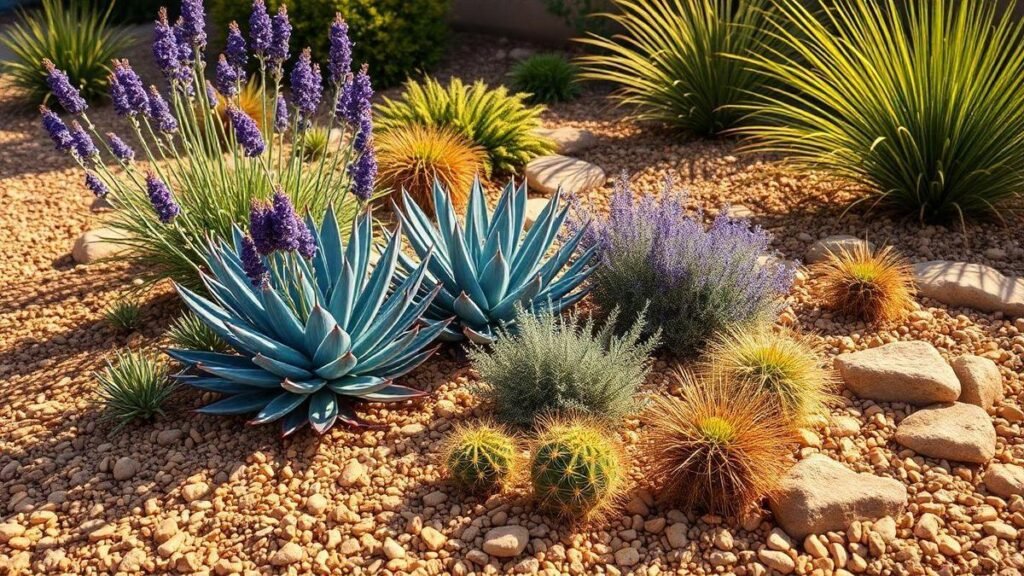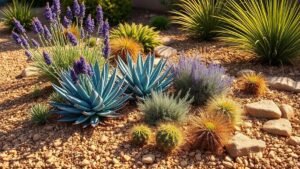Drought Resistant Plants for sustainable gardening in dry regions
Drought Resistant Plants for sustainable gardening in dry regions are my secret weapon—my garden’s excuse for sipping less water. I fell for them because they cut my watering drama and my guilt. I’ll show how they help pollinators, how I prep soil with mulch and smart drip irrigation, and which succulents, perennials, shrubs, and groundcovers actually thrive. I favor native picks for real resilience, use simple xeriscape tricks for curb appeal, and share fuss‑free care tips so the yard looks great with almost no drama.
Key Takeaway
- I choose succulents and native plants that need almost no water
- I water deep and rarely so plants grow tough roots
- I mulch to keep soil moist and cut evaporation
- I group plants by water needs to avoid overwatering
- I pick hardy plants that laugh at heat and drought
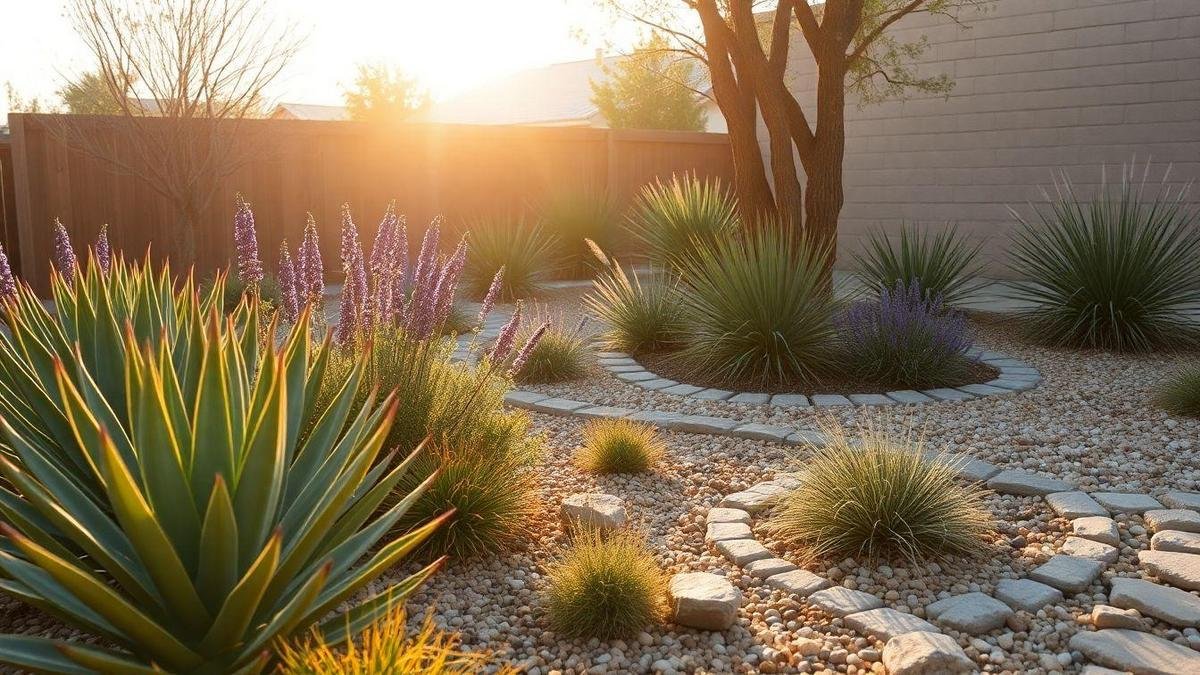
Why I Choose Drought Resistant Plants for sustainable gardening in dry regions
I picked Drought Resistant Plants for sustainable gardening in dry regions because I like plants that are smart and stingy with water. In a sunny, dry climate I still get color and life while I water less and smile more.
How drought-tolerant plants cut my water bill and my guilt
I went from daily sprinkling to sipping like a wise old cactus. The result: a smaller water bill and less shame about wasting resources. Simple, effective moves:
- Mulch to keep soil moist.
- Group by water needs.
- Encourage deep roots with less frequent watering.
I check soil with my finger—if it’s moist, I wait. That habit saved time and cash, and the plants still look proud. For additional water-saving tactics and timer setups I follow practical water-saving tips for home gardeners.
How drought gardens help pollinators and wildlife
Drought lovers aren’t lonely. They feed bees, butterflies, and birds—many bloom for long periods or produce seeds that birds adore. Native sages and lavender brought hummingbirds and steady bee traffic to my yard; the right plants are a small hotel for wildlife that pays back in pollination and charm.
Real water savings — stats and quick facts
No fluff—just what changed for me.
| Measure | Before (lawn thirsty plants) | After (drought garden) |
|---|---|---|
| Watering routine | 3× per week | Once every 10–14 days |
| Rough water use | High | ~50–70% less for me |
| Work needed | Mow, water, fret | Prune, check, enjoy |
| Wildlife visits | Few | Regular bees, butterflies, birds |
Quick facts I watch:
- Drought plants often have deep roots or succulent leaves—that saves water.
- Mulch cuts evaporation.
- Native choices attract more local pollinators.
Conclusion: less water less fuss = lower bill and a happier yard.
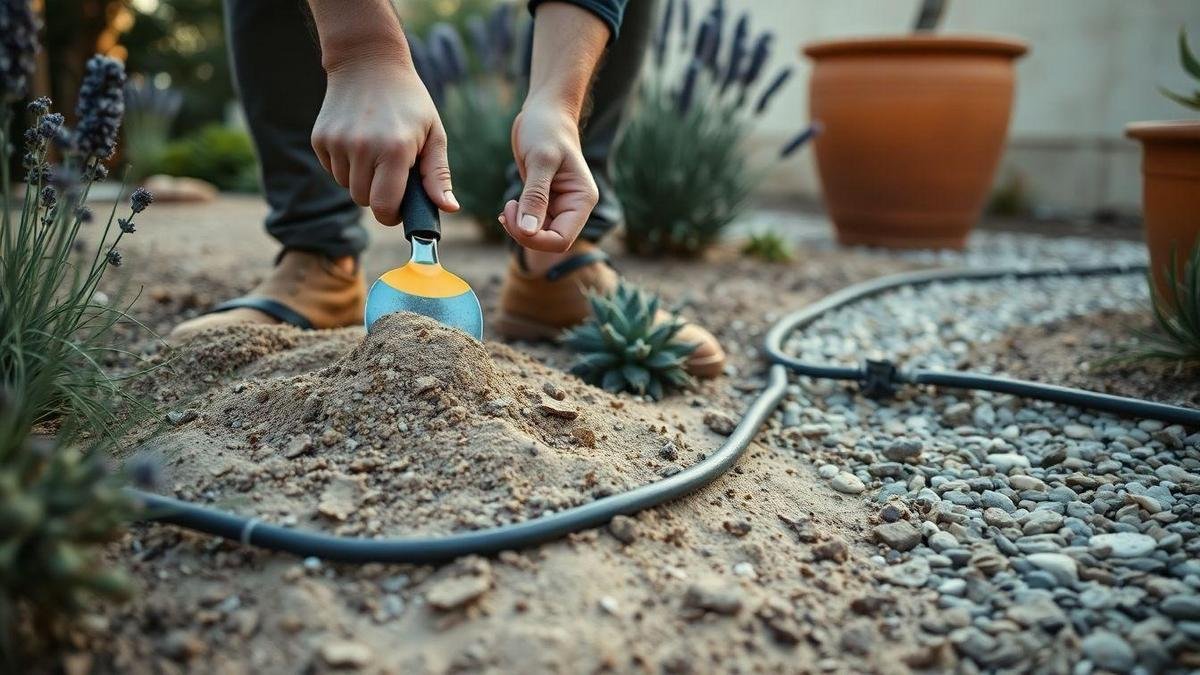
How I prep soil and water wisely for a dry garden
Mulch, soil amendments, and drainage tips for low-water native plants
Treat soil like a sponge: if it holds water, plants thank you. I prefer coarse bark or gravel mulch around natives—both last and breathe. Add compost to poor dirt to improve water retention. For heavy clay, mix in sharp sand or small gravel to improve drainage; for sandy soil, add compost. For more on soil amendments I use the guide to organic fertilizers and amendments.
| Material | Use | Best for |
|---|---|---|
| Coarse bark mulch | Retains moisture, cuts weeds | Native shrubs, perennials |
| Gravel mulch | Reduces evaporation, keeps stems dry | Succulents, drought lovers |
| Compost | Adds organic matter, improves water holding | Sandy or poor soils |
| Sharp sand / small gravel | Improves drainage in clay | Pots, raised beds, heavy clay |
Raise beds or plant on mounds where water puddles—roots rot if water sits. If you prefer raised beds, see tips on starting a raised-bed garden. Most Drought Resistant Plants for sustainable gardening in dry regions prefer lean, well-drained soil and don’t want heavy feeding.
Drip irrigation, deep infrequent watering, and smart timers
Think of drip irrigation like a slow coffee maker—slow and steady wins. Drip irrigation delivers water to roots, wastes less, and keeps leaves dry.
- Use emitters along root lines (1–2 per shrub; multiple for large trees).
- Add a filter and pressure regulator to prevent clogs.
- Set timers for early morning to reduce evaporation; run longer but less often to encourage deep roots.
I also collect rain when possible and route it into the system—see ideas for a DIY rainwater-collection system to top up irrigation.
| Item | Tip |
|---|---|
| Emitters | 1–2 per small shrub; 4 for trees |
| Timer | Water early; longer runs, fewer days |
| Pressure regulator / filter | Prevent clogs and uneven flow |
| Layout | Place tubing at root line, not at trunk |
I test soil with a trowel: if water pools, reduce run time; if soil is bone dry 2″ down after watering, add time. For preventing the usual mistakes, I compare notes with tips on overwatering and underwatering.
Practical watering schedules and soil-depth tips
Rules: water slow. Water deep. Let soil dry between drinks.
| Plant stage/type | Root depth to check | Typical frequency |
|---|---|---|
| Seedlings / new plants | 1–2 inches | Every 1–3 days (short runs) |
| Young established shrubs | 3–6 inches | Twice weekly (longer runs) |
| Mature shrubs / small trees | 6–12 inches | Once weekly to biweekly |
| Succulents / very drought-hardy | 1–3 inches | Every 2–4 weeks or when dry |
Use a moisture meter or your finger; wet at listed depth = skip watering. For hand watering, slow-soak 10–20 minutes per zone to wet root zone.

How I pick drought-tolerant plants: succulents, perennials, shrubs and groundcovers
My top rule: favor Drought Resistant Plants for sustainable gardening in dry regions—look for deep roots, water-storing tissue, and plants that settle in once established.
Succulents — water bankers and easy species
Succulents stash moisture in fleshy leaves or stems and often use CAM photosynthesis to save water at night. Give them bright light and deep, infrequent water. For inspiration and species options I used a detailed succulent guide.
| Species | Water habit | Hardiness | Quick note |
|---|---|---|---|
| Aloe | Infrequent | Mild frost tolerant | Great in pots |
| Agave | Very low | Hardy | Dramatic rosettes |
| Echeveria | Low | Frost-sensitive | Pretty rosettes |
| Sedum | Low | Very hardy | Spreads; good in rock gardens |
| Sempervivum | Low | Very hardy | Survives freezes; multiplies |
| Barrel Cactus | Very low | Hardy | Classic desert look |
Water deeply, then wait. Most succulents prefer that rhythm.
Drought-tolerant perennials and shrubs for color and structure
Perennials give repeat bloom; shrubs provide backbone. Both reduce water needs compared to lawns. For more low-maintenance flowering choices see best perennial flowers and low-maintenance plant picks.
| Plant type | Examples | Why I pick them |
|---|---|---|
| Perennials | Lavender, Yarrow, Russian sage, Catmint | Long bloom, low water once established, pollinator-friendly |
| Shrubs | Rosemary, Manzanita, Ceanothus, Pyracantha | Shape, scent, little water after roots set |
Tips: plant in spring/fall, mulch to cut evaporation, and prune lightly—severe pruning increases thirst.
Top xeriscape plants and drought-resistant groundcovers
Groundcovers stop bare dirt from frying and protect roots.
| Groundcover | Spread habit | Best use |
|---|---|---|
| Thyme (creeping) | Low, spreading | Walkways, rock gardens; fragrant when stepped on |
| Sedum (stonecrop) | Mat-forming | Rock walls, sunny slopes |
| Ice plant | Spreading | Bright flowers; very drought-tolerant |
| Dymondia | Low mat | Between pavers; tolerates light foot traffic |
| Gazania | Clumping | Bold flowers; loves sun and dry soil |
I mix heights and leaf types to keep soil cooler and provide year-round interest.
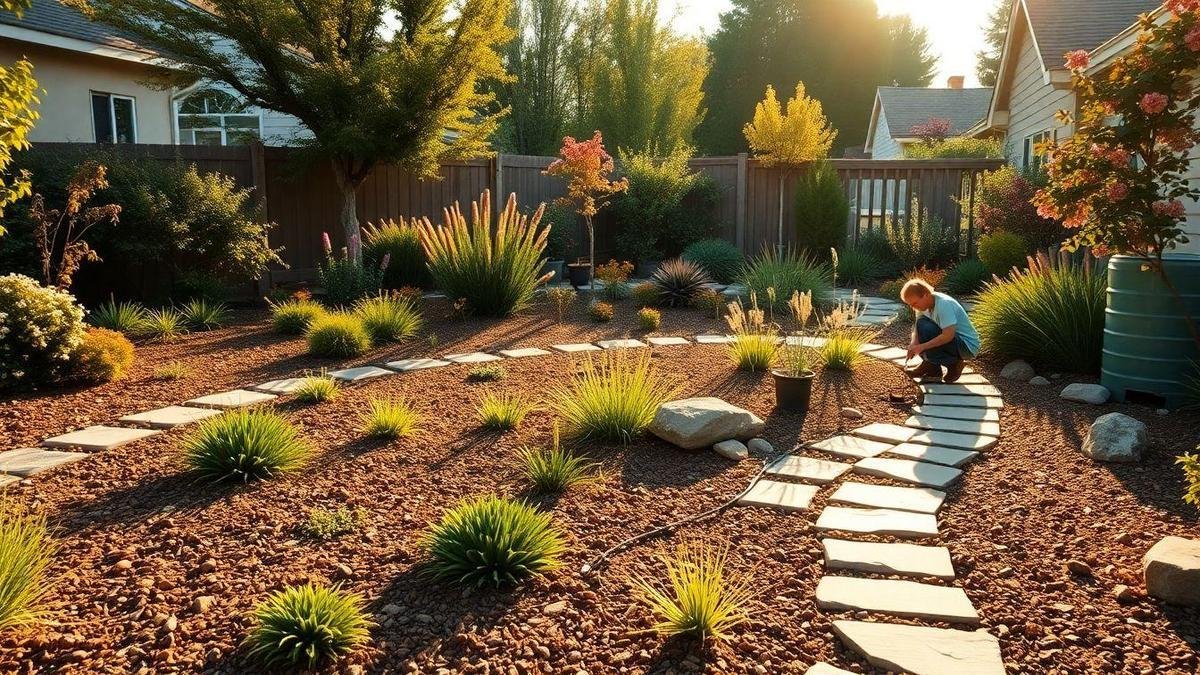
How I use low-water native plants to build a resilient yard
Why native low-water plants often outperform exotics
Native plants know the local rhythm. They root deep, endure summer heat, and attract local pollinators. Benefits:
- Less water use
- Fewer pests and less spraying
- Longer-lived in harsh summers
This is what I mean by using Drought Resistant Plants for sustainable gardening in dry regions: honest, practical, and effective. For regional picks and wildlife benefits see native plant recommendations and ideas to create a wildlife-friendly garden.
Finding low-water native plants for your climate and soil
Find your climate zone, check your soil (sand, clay, loam), and match plants to:
- Climate (hot-dry, coastal, plateau)
- Soil (sandy, clay, well-drained)
- Sun (full, part, shade)
| Climate / Soil | Example native plants | Water habit |
|---|---|---|
| Hot, sandy (Southwest) | Agave, Penstemon, Rabbitbrush | Very low once established |
| Mediterranean, well-drained | Lavender, Rosemary, Salvia | Low; dislikes wet feet |
| Prairie, clay or loam | Purple Coneflower, Little Bluestem, Black-eyed Susan | Moderate to low; tolerates heat |
I group similar water needs together so my drip system runs less and smarter.
Reliable resources to locate native drought-tolerant plants
- Local Extension Office — soil tests and local lists
- Native Plant Societies — local expertise
- Lady Bird Johnson Wildflower Center — searchable by region
- iNaturalist — see what grows near your street
- Local native plant nurseries — plants adapted to your area

How I design an attractive xeriscape with Drought Resistant Plants for sustainable gardening in dry regions
I build gardens that sip, not gulp. Using Drought Resistant Plants for sustainable gardening in dry regions as the core, I mix texture, color, and rockwork for interest. Paths, seating, and hardscape reduce thirsty lawn area and add style. For overall layout principles I also reference garden design basics and elements from permaculture that fit xeriscapes.
Using texture, color, and hardscape
Layer spiky agave, soft lamb’s ear, and airy grasses. Choose lasting colors—silver foliage, blue‑green succulents, and purple or yellow blooms. Hardscape like gravel, flagstone, and boulders frames plants and reduces bare soil.
| Plant | Water need | Sun | Texture / Color |
|---|---|---|---|
| Agave | Low | Full sun | Bold, architectural |
| Lavender | Low | Full sun | Silvery leaves, purple blooms |
| Sedum | Low | Full sun | Fleshy leaves, bright flowers |
| Russian Sage | Low | Full sun | Tall, feathery, blue-purple |
| Yarrow | Low | Full sun | Flat flower clusters, feathery leaves |
Layouts for small yards, containers, and curb appeal
- Small yard: plant in layers—tall in back, low in front; see small garden layout ideas.
- Containers: use a thriller, filler, spiller trio with gritty soil and pebbles—also check best plants for urban containers and creative ways to reuse household items for planters.
- Curb appeal: repeat a few plants for cohesion; taller plants near the house, low bloomers near the sidewalk.
Plant spacing and grouping tips
Group by water needs and space appropriately to reduce disease and allow each plant to shine.
| Plant type | Typical spacing |
|---|---|
| Small succulents | 6–12 inches |
| Perennials / low shrubs | 12–24 inches |
| Medium shrubs | 24–48 inches |
| Large shrubs / small trees | 4–6 feet |
Plant denser the first year for shading soil, then thin as needed. Mulch (2–3 inches) is your friend but keep it away from crowns.
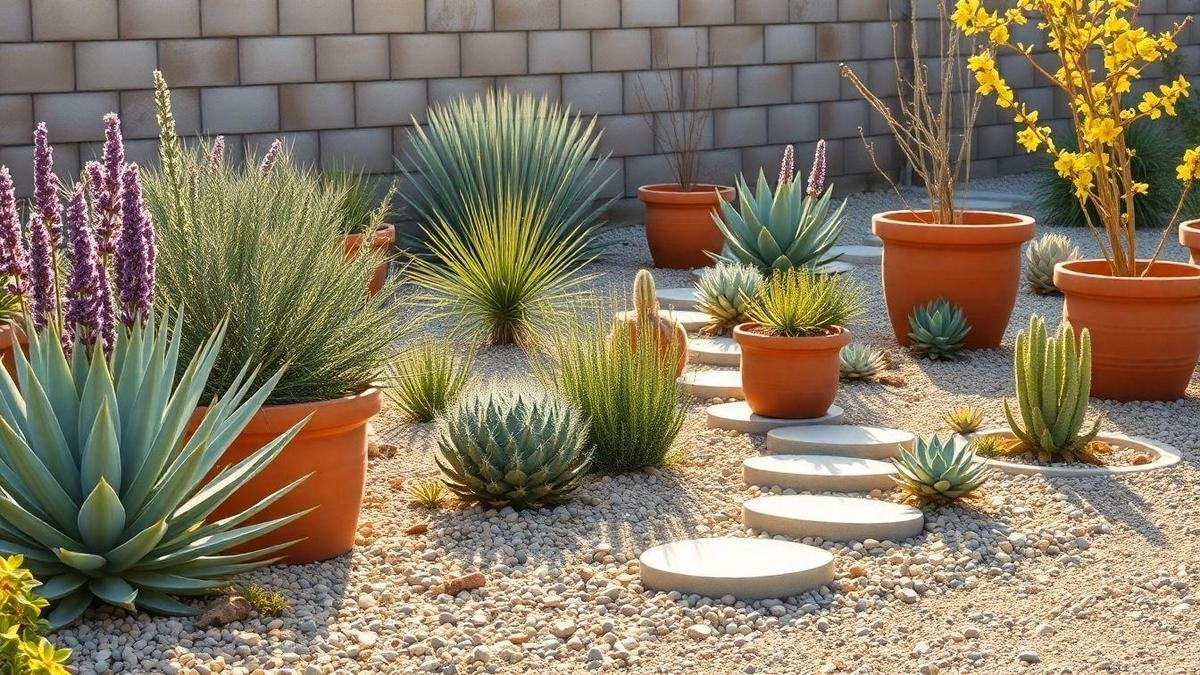
How I establish and care for drought-resistant plants (minimal fuss)
I pick plants that sip, not guzzle, and I plant with a plan.
Planting techniques and root care
- Dig a hole wide enough for roots to sit naturally; loosen surrounding soil.
- Plant at the same level as the pot—don’t bury the crown.
- Tease circling roots gently.
- Add only a little organic matter for very poor soils; use grit for clay.
- Give a deep drink after planting, then water less. First season: a few deep soaks; after that: far less.
If you prefer low-disturbance methods, consider no-dig garden techniques for planting and soil-building.
| Plant type | Root habit | First-year watering | Spacing |
|---|---|---|---|
| Succulents (Aloe, Sedum) | Shallow, fibrous | Weekly deep soak, then dry | 6–12 in |
| Mediterranean shrubs (Lavender, Rosemary) | Medium depth | 1–2× week first season | 2–4 ft |
| Xeric perennials (Salvia, Echinacea) | Deep tap or fibrous | Weekly first season | 1–3 ft |
Watch the plant, not a calendar—plump leaves = back off.
Seasonal maintenance: pruning, mulching, and easing off watering
- Spring: prune dead wood, check mulch, start light watering.
- Summer: water deeply but less often, remove dead tops. See extra tips for hot weather in summer gardening tips.
- Fall: reduce watering, cut back perennials if needed.
- Winter: protect frost-sensitive succulents; keep soil mostly dry.
Mulch with coarse materials near Mediterranean plants; keep organic mulch away from crowns.
Troubleshooting common issues
- Yellow, soggy leaves = too much water → let soil dry, improve drainage.
- Shriveled leaves = underwatering → deep soak.
- Leggy growth = too little sun → move to brighter spot or prune.
- Mealybugs/scale = wipe with alcohol or use insecticidal soap.
- Root rot after heavy rains = lift, trim rotten roots, replant in better-draining mix.
- Winter damage on succulents = cut dead tissue, give a dry rest.
Finger test and leaf condition are simple, reliable signals.
Conclusion
I love my drought‑resistant plants because they make my yard proud and my water bill ashamed. They sip, not guzzle, attract pollinators, withstand heat, and let me garden with far less drama. My routine: soil prep, mulch, drip irrigation, group by water needs, and water deep and rarely. The payoff: a resilient, attractive xeriscape that saves water and invites wildlife.
If you want a practical, cheeky guide to using Drought Resistant Plants for sustainable gardening in dry regions, this approach is honest and it works.
Read more at https://myxaro.com.
Frequently Asked Questions
Q: Which plants work best in a dry garden?
A: Agave, Sedum, Lavender, Rosemary, Yucca, cactus, and native grasses—plants that sip water like polite camels. See more options in the succulent guide and the low-maintenance plant list.
Q: How often should I water drought-resistant plants?
A: Generally deep and rare—once every 2–4 weeks for very drought-hardy plants, more often for new transplants or during extreme heat. Check soil depth and consult water-saving timing tips.
Q: How do I prep soil for dry gardening?
A: Use well-draining mixes. Add grit or sand for clay and a little compost for sandy soil. Avoid heavy, moisture-retaining amendments near Mediterranean types. For step-by-step amendment ideas see organic soil amendments.
Q: Can these plants help with sustainable landscaping?
A: Yes—Drought Resistant Plants for sustainable gardening in dry regions reduce water use, lower maintenance, and support local wildlife. For native-focused strategies, check native plant resources.
Q: Any quick maintenance tips?
A: Mulch, prune lightly, check soil by finger, and ignore them a bit—they repay you with low fuss and high charm. For small gardens, try the easy-care flower list and space-maximizing ideas.

